|
Modern Classic SLRs Series :
Nikon
F Motor - Battery Packs and Accessories
|
| |
 |
Nikon 250-Exposure
Bulk Film Loader (Pix shown here is with the 250 exposure film cassette)
- Because I am being
exceptionally lazy, I'm just going to repeat the F250's loading instructions:
- put the bulk-film
supply on the film drum spindle, with the film coming over the axis, not under.
- put the MZ-1's
spindle on the winding spool
Photo
Showcase on Nikon
F250
|
|
- trim leader (to
appox. 3cm long and 2cm wide) and thread film into the MZ-1's spindle, taking care
to engage the sprockets and passing film over the axis of the MZ-1's spindle
- swing the film
pressure lever over the film
- pull and turn
the exposure-frame dial to set the total number of frames to be wound
- wind (at appox.
2-3 frames/sec) until you reach the preset, which will cause the winding to stop
- cut the film approximately
halfway between spools
-
Remember to do
all this in a darkroom. The preset dial has glow-in-the-dark numerals to help you
along, although they are possibly made from tritium instead of phosphorescent paint.
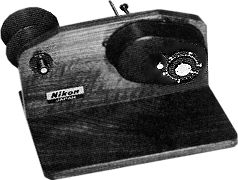 |
MZ-1 250-Exposure
Cassette
- The MZ-1 is one
of Nikon's most enduring accessories, meaning that the same cassettes you bought
for your F250 can be used in your MF-24. Not even the BR-2 can be used so nicely.
Yes! I hope to
bore you by again describing how to open the cassette:
- press the silver
button under the "J" in "Japan"
- rotate the shell
relative to the top plate until the openings in the two halves line up
- separate the two
halves
|
-
-
If that wasn't
enough, here's how to close it, again!
- slide "bottom
half" over "top half"
- turn "top
half" clockwise until you hear two clicks, meaning that the catch has fallen
into place
36-Exposure Cassette
 |
Nikon's reloadable standard
cassette, recommended for use with the F36, doesn't have any felt. As a result, it
is probably a bit faster to use and more battery-efficient (less drag), but given
the cheapness of batteries and the convenience of preloaded film, there is no compelling
reason to use it today.
|
-
Pistol Grip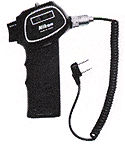 Early type for F36 and F250
Early type for F36 and F250
Switching Cord
for Model II Grip permits electrical operation of F36 motor drive with cordless battery
pack.
Mechanical Cable for Model II Grip is used to trigger the shutter release on the
camera body.
-
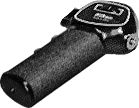 |
This Pistol Grip has a microswitch
and may be used with either motorised or non-motorised cameras, as it accepts both
the motor connecting cord or a cable release. It is appropriate for motorised cameras
with the Cord Pack and has a cable for its attachment. It offers single-shot or continuous
mode.
|
Pistol
Grip Model 2
-
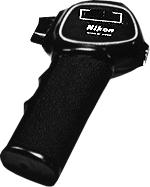 |
This Pistol Grip is appropriate
for only motorised cameras with cordless battery packs (i.e. Cordless Pack or MB-2/3).
It connects to the motor drive via a cord; it offers single-shot or continuous mode.
With all pistol grips, don't attach it to the tripod socket of the old non-AI 300f/4.5,
as the F36 with Cordless Pack will interfere with the fit.
|
ST Pistol Grip

for use with standard
battery pack is equipped with trigger-controlled micro switch and cord for electrical
operation of F36 or F250 motor drive.
30 feet Extension Cord 
A 3-conductor cord
which leads directly into the Standard Battery Pack to permit a Nikon F equipped
with either F36 or F250 motor drive to be operated from a distance up to 30 feet.
Wireless Control Model 2
- Components:
- Transmitter (using
4 transistors)
- Receiver (using
20 transistors)
- Transmission
Frequency:
- 27.120 mHz (or
any other frequencies specified by respective countries) (ed. -- not sure if it's
Mega or milli-Hz)
- Modulation:
- f0: 2300 Hz
- f1: 2500 Hz
- f2: 2700 Hz
- f3: 2900 Hz
- Range:
- 1 km (0.6 mi)
maximum
- 300m (1000 ft)
typical
- Power Source:
- Transmitter: 8
1.5V "AA"-type cells
- Receiver: 4 1.5V
"AA"-type cells
- Dimensions
and Weight:
- Transmitter: appox.
40 x 68 x 200mm; 760g (w/ batteries)
- Receiver: appox.
40 x 85 x 200mm; 800g (w/ batteries)
- Transmitter: appox.
1.6 x 2.7 x 7.9 in.; 27 oz. (w/ batteries)
- Receiver: appox.
1.6 x 3.3 x 7.9 in.; 28.5 oz. (w/ batteries)
-
You can directly
hook the receiver into the Cordless Pack via a special cord. Otherwise, you need
a different cord to hook the receiver across R1 and R2 of the Relay Box, for use
with the Cord Pack. Since the receiver has two "OUTPUT" sockets, you can
connect a couple of remote motorised cameras to fire simultaneously.
The cord that comes standard with the Wireless Remote set has the appropriate plug
for an "OUTPUT" socket on one end and two leads coming out the other end,
one red and one black. These are meant to be plugged into the R1 and R2 terminals
of the Relay Box, but may be adapted (via a two-prong plug) to use on the Cordless
Pack. Button 1 on the Transmitter fires "OUTPUT 1", Button 2 fires "OUTPUT
2", and Button 3 fires both "OUTPUT"s. It is important to keep the
button depressed as long as necessary -- 50 msec for shutter speeds 1/125 and faster,
1.5 sec for slower shutter speeds -- to fire the shutter.
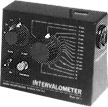 |
NC-2 Intervalometer
This instrument enables the motor-equipped Nikon F to take pictures automatically
at predetermined intervals from '/: second to more than 16 minutes. Once started
it requires no attention until the last exposure has been made. Time-lapse photography,
as this technique is called, finds application in virtually every field of research
and development. It is one of many areas where the F250 motor drive with its tremendous
film capacity provides ready-made capabilities far beyond the scope of any other
35mm system.
|
The Nikon Intervalometer
uses a 30-volt battery housed inside the unit. Where the motor drive is equipped
with Standard Battery Pack, the Intervalometer is used with the Relay Box accessory.
In the case of the Cordless Battery Pack, the Intervalometer is connected directly.
- Time Intervals:
- 0.5, 1, 2, 3,
4, 5, 6, 7, 8, 9, 10, 15, 20, 30, 40, 50 sec. available as base intervals
- base intervals
may be multipled by 2, 4, or 10 times
- Power Source:
- 8 "AA"-type
batteries
- external 12V DC
source (no amperage given)
- Size and Weight:
- 115 x 150 x 115mm,
661g
- 4.5 x 6 x 4.5
in., 1.5 lb.
-
The Nikon NC-2
offers fairly good accuracy (+/- 3%) in timing, and is remarkably flexible. One large
knob selects the base time delay between consecutive shots, and a smaller knob to
its left selects the "multiplier" factor; e.g. to set a 4-second delay,
you could either set the "multiplier" to 1x and the base interval to 4
sec. or "multiplier" at 4x and a base interval of 1 sec. Immediately below
the "multiplier" knob are two switches: one toggle switch controls the
power (on/off/savings) and one push button controls the timer start. The power switch
may be turned to the "save" position to select a battery-saving circuit
when the NC-2 is to be used for longer than three hours. The push button is depressed
once to begin automatic timing; while the NC-2 is timing, it may be depressed at
any time to immediately fire the shutter (the automatic timer does not reset after
you press this button, so it will operate as scheduled, regardless of how many times
you press).
-
Three sockets are
on top of the NC-2, a remote control (two-prong) socket and external power (coaxial)
socket on the left and a timing out (two-prong) socket on the right. When the external
power socket is in use, the batteries inside the unit are disconnected. The timing
out socket is connected to either the Cordless Pack (via the MEx cords) or the Relay
Box (via the AE-x cords); AE-x cords may be connected to the remote control socket
to remotely begin timing or immediately fire the shutter, as the push button on the
front of the NC-2 does.
Relay Box
 |
Used with Standard
Battery Pack, permits a Nikon F equipped with either F36 or F250 motor drive to be
operated through a conventional 2-conductor cord, terminating in any circuit closing
device: manual switch, intervalometer, radio control receiver, or other. May also
be operated by button on relay box. Not required with Cordless Battery Pack.
|
|
(Early version
of the Relay box by Nikon)
The Relay Box made
all kinds of remote-control photography possible with the F and F36 or F250. It is
a fairly unassuming box not really bristling with terminals, but with enough to cause
some confusion. The left side of the box has four terminals; the ones close to the
top edge, from left to right, are the power-supply terminal to the motor (labelled
"M") and the power-input terminal from the battery pack (labelled "B").
Near the bottom edge are the DC input terminals, clearly labelled "+" and
"-", which may be used in lieu of the battery pack input. The right side
has two terminals, R1 and R2, which must be connected by a switching mechanism of
some kind, via one of the AE-x cords (or by a switch of your own design). The top
of the box has a S/C rocker switch and a shutter tripping button. Yes, this one,
too, overrides the one on the back of the F36 or F250. The Relay Box is most appropriate
for long runs of remote cords or adapting the Cord Pack to more remoteness.
The Relay Box is
probably amazingly difficult to get. If you want to drive yourself crazy, you might
want to hunt up the accessory AC mains adapter for the Relay Box (which hooks into
the DC input terminals and supplies DC current sufficient for up to 4 motorised cameras)
So long as the resistance across R1 and R2 does not exceed 100 Ohms, your wire can
be as long as you like (my source quotes 1-2 mi. (1.6-3.2km)!). It looks as though
the time lag between closing R1 and R2 and releasing the shutter is approximately
40-80 msec, with a synchronisation error between simultaneously-fired cameras of
around 20 msec. Just to make your hunt harder, the Relay Box was originally supplied
with a 1m connecting cord between it and the battery pack.
Battery tester
 |
Miniature voltmeter
instantly checks condition of motor batteries in Standard Battery Pack. Indicates
voltage as well as the point when batteries should be replaced.
|
| Back | to Index Page - Motor
Drive for Nikon F
|
Next | Part II - Batteries
for Motor
Main Reference map in HTML
& PDF:
Body
with FTN Finder
| FTN finder | camera body |
External
links
for F & F2
| Back | to Nikon-F - Main Index Page
Other
Nikon F Variations
The
Eyes of Nikon:-
Nippon
Kogaku KK Rangefinder
RF-Nikkor
lenses:-
Main Index Page
Nikon
Auto
Focus
Nikkor lenses:- Main Index Page
Nikon
Manual
Focus
Nikkor lenses-
Main Index Page
Fisheye-Nikkor Lenses - Circular | Full Frame |
Ultrawides Lenses - 13mm15mm18mm20mm | Wideangle Lenses - 24mm28mm35mm |
Standard Lenses - 45mm 50mm 58mm | Telephoto
Lenses - 85mm105mm135mm180mm & 200mm |
Super-Telephoto
Lenses - 300mm 400mm 500mm 600mm 800mm 1200mm |
Special
Application lenses:
Micro-Nikkor Lenses - 50mm~55mm -60mm 85mm -105mm 200mm Micro-Zoom 70-180mm
Perspective Control (PC) - 28mm 35mm
PC-Micro 85mm
Dedicated
Lenses for Nikon F3AF: AF 80mm f/2.8 | AF 200mm f/3.5 EDIF
Depth
of Field Control (DC): 105mm 135mm
Medical
Nikkor: 120mm 200mm
Reflex-Nikkor Lenses - 500mm 1000mm 2000mm
Others:
Noct Nikkor |
OP-Nikkor | UV Nikkor 55mm 105mm |
Focusing Units | Bellows-Nikkor 105mm 135mm
Nikon
Series E Lenses: 28mm35mm50mm100mm135mm |
E-Series Zoom lenses: 36~72mm75~150mm70~210mm
MF Zoom-Nikkor Lenses: 25~50mm | 28~45mm | 28~50mm | 28~85mm | 35~70mm | 36~72mm E | 35~85mm | 35~105mm | 35~135mm |
35~200mm | 43~86mm | 50~135mm | 50~300mm | 70~210mm E | 75~150mm E | 80~200mm | 85~250mm |
100~300mm | 180~600mm | 200~400mm | 200~600mm | 360~1200mm | 1200~1700mm
Tele-Converters: TC-1 | TC-2 | TC-200 | TC-201 | TC-300 | TC-301 | TC-14 | TC-14A | TC-14B | TC-14C | TC-14E | TC-16 | TC-16A | TC-20E

Nikon F
| Nikon F2 |
Nikon
F3
| Nikon F4 |
Nikon
F5
| Nikon F6 |
Nikkormat / Nikomat |
Nikon FM
| Nikon FE/ FA | Nikon EM/FG/FG20 | Nikon Digital SLRs | Nikon - Other models
MIR Supports for Photographic Community: Various Message Boards/Community
Forums
Nikon
F-series|
Nikon
F2-series|
Nikon
F3-series|
Nikon F4-series| Nikon
F5-series|Nikkormat/Nikomat-series
Nikon FM-series|Nikon
FE-series|Nikon
FA|Nikon
Digital
SLR
series|Various
Nikon
Models|Nikkor
Optic
-shared
Others:- Free Trade Zone - Photography| Free Trade Zone - Business Community |Free To Zouk - Photographic Community
Apple's Mac Public Community Message Board | Windows based PC &
Apple/Mac
Public Community Trade Exchange Centre
Recommended links to understand
more technical details related to the Nikkor F-mount and production Serial Number:
http://rick_oleson.tripod.com/index-153.html by: my friend, Rick Oleson
http://www.zi.ku.dk/personal/lhhansen/photo/fmount.htm by: Hansen, Lars Holst
http://www.mir.com.my/rb/photography/hardwares/nikonfmount/lens2.htm
http://www.photosynthesis.co.nz/nikon/serialno.html
About
this photographic
site.
Home - Photography
In Malaysia

Copyright
© 1998. leofoo ®. MIR Web Development Team.
[Left Brain][Right brain][Home-MIR]
[Invention][Art & Design][Clubs]
[Portfolios][On assignments]
[Trading
room][Knowledge
& Resources]
[Free-trade-zone][Thoughts & opinions][Links]


 Early type for F36 and F250
Early type for F36 and F250




